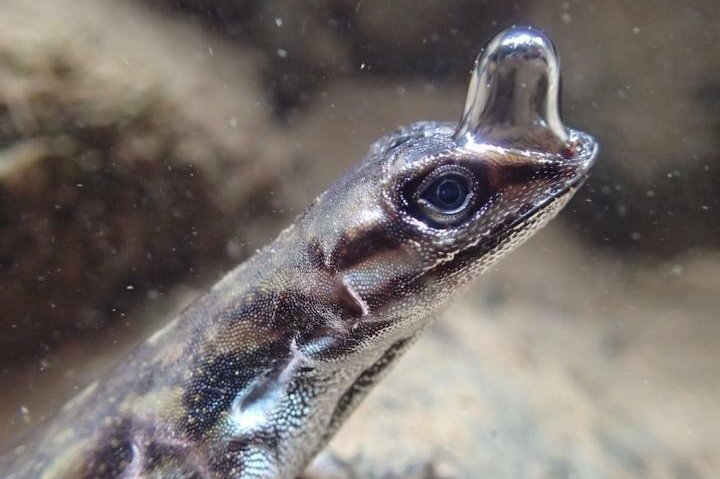Researchers estimate a series of air pockets and one large air bubble allow the water anole to breathe fresh air underwater. Photo by Lindsey Swierk
March 26 (UPI) -- The water anole, a lizard species found in Costa Rica and Panama, uses a unique underwater breathing technique to stay under water for up to 16 minutes, according to a new study.
Water anoles have previously been observed diving underwater, but only recently were scientists able to characterize the species' underwater respiration system.
"Diving underwater and remaining there for a long time is an anti-predator strategy for water anoles," Lindsey Swierk, an assistant research professor of biological sciences at Binghamton University, said in a news release. "These lizards aren't particularly speedy, and taking to the water is a very effective option."
Swierk said many of her attempts to catch water anole specimens have been thwarted by their impressive diving abilities. Now she knows how they manage to stay underwater for so long.
According Swierk's observations -- detailed this week in the March issue of the journal Herpetological Review -- water anoles can use a recycled air bubble attached to their nose to breathe underwater.
Researchers had previously identified water insects in the stomachs of water anole specimens, evidence that the species may dive for reasons other than evasion. Swierk decided to get a closer look at the lizard's underwater behavior.
"Finding evidence suggesting that water anoles 'breathe' under water was serendipitous, and not part of my original research plan," she said. "I was impressed and pretty confused about the length of the dive, which gave me an itch to take a closer look with an underwater camera in the next couple of years. That's when I saw that the anoles appeared to be rebreathing a bubble of air that covered their heads."
Swierk estimates the air bubble is adjoined to multiple pockets of fresh air. As the lizard breathes in and out, it is able to trade some old air for new air in its bubble.
"It's additionally possible that the air bubble plays a role in allowing an anole to get rid of carbon dioxide," Swierk said. "I suspect that there might be morphological adaptations, namely the shape of the top of the anole's head, which allows a large bubble of air to cling to it easily."
Swierk and her colleagues hope future studies of the water anole will provide insights into the physiology of the lizard's underwater breathing system, as well as offer clues as to its evolutionary origins.
"If future investigation reveals that this rebreathing behavior is adaptive, then I would imagine that it is a trait that evolved over time to allow water anoles, and perhaps similar anole species, to thrive in their aquatic habitats," said Swierk.
Late last year, scientists at the University of Oxford detailed how geckos glide across the surface of water to escape predators.















